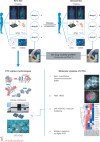The evolving genomic classification of lung cancer
- PMID: 24114583
- PMCID: PMC4285848
- DOI: 10.1002/path.4275
The evolving genomic classification of lung cancer
Abstract
EGFR gene mutations and ALK gene fusions are well-characterized molecular targets in NSCLC. Activating alterations in a variety of potential oncogenic driver genes have also been identified in NSCLC, including ROS1, RET, MET, HER2, and BRAF. Together with EGFR and ALK, these mutations account for ∼20% of NSCLCs. The identification of these oncogenic drivers has led to the design of rationally targeted therapies that have produced superior clinical outcomes in tumours harbouring these mutations. Many patients, however, have de novo or acquired resistance to these therapies. In addition, most NSCLCs are genetically complex tumours harbouring multiple potential activating events. For these patients, disease subsets are likely to be defined by combination strategies involving a number of targeted agents. These targets include FGFR1, PTEN, MET, MEK, PD-1/PD-L1, and NaPi2b. In light of the myriad new biomarkers and targeted agents, multiplex testing strategies will be invaluable in identifying the appropriate patients for each therapy and enabling targeted agents to be channelled to the patients most likely to gain benefit. The challenge now is how best to interpret the results of these genomic tests, in the context of other clinical data, to optimize treatment choices in NSCLC.
Keywords: ALK; EGFR; NSCLC; biomarkers; genomic classification; lung cancer; molecular targets; monoclonal antibodies; multiplex testing; tyrosine-kinase inhibitors.
© 2013 The Authors. Journal of Pathology published by John Wiley & Sons Ltd on behalf of Pathological Society of Great Britain and Ireland.
Figures




References
-
- Travis WB, Brambilla A, Müller-Hermelinck HK, et al. World Health Organization Classification of Tumours. Pathology and Genetics of Tumours of the Lung, Pleura, Thymus and Heart. Lyon: IARC Press; 2004.
-
- Pao W, Girard N. New driver mutations in non-small-cell lung cancer. Lancet Oncol. 2011;12::175–180. - PubMed
-
- Schiller J, Harrington D, Belani C, et al. Comparison of four chemotherapy regimens for advanced non-small-cell lung cancer. N Engl J Med. 2002;346::92–98. - PubMed
-
- Jemal A, Bray F, Center MM, et al. Global cancer statistics. CA Cancer J Clin. 2011;61::69–90. - PubMed
-
- American Cancer Society. Atlanta: American Cancer Society; 2012. Cancer Facts & Figures. 2012 [Accessed 22 August 2013]. Available from: http://www.cancer.org/acs/groups/content/@epidemiologysurveilance/docume....
Publication types
MeSH terms
Substances
LinkOut - more resources
Full Text Sources
Other Literature Sources
Medical
Research Materials
Miscellaneous

